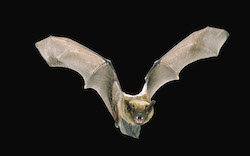SEJournal Online is the digital news magazine of the Society of Environmental Journalists. Learn more about SEJournal Online, including submission, subscription and advertising information.
TipSheet: Why Reporters Should Go to Bat for Bats
Forget the Dracula movies you may see on TV this Halloween season. Bats are your friends, and probably your neighbors. And they need your help.
Bats are of interest to environmental reporters for any number of reasons. One is that they eat disease-causing mosquitoes and other harmful insects (some eat half their weight in insects every night). They also help pollinate flowers and vegetables, and they help distribute fruit seeds.
Another is that people actually love reading about bats — which may be enough of a reason to report on them. This despite the fact that many people are creeped out by bats (or perhaps because of it).
But many bat species are endangered, another reason environmental journalists may want to report on them. Worldwide, the number of bat species has been estimated somewhere between 1,000 and 1,240. Of these, roughly 47 can be found in the United States.
Some of those U.S. species are listed as endangered or threatened by the U.S. Fish & Wildlife Service. They include the Indiana bat, gray bat, Hawaiian hoary bat, Northern long-eared bat, Lesser long-nosed bat, Little Mariana fruit bat, Mariana fruit bat, Mexican long-nosed bat (Saussure's long-nosed bat), Ozark big-eared bat, Virginia big-eared bat and the Florida bonneted bat.
One of the biggest threats to many bat species is loss of habitat. Of course many bats love caves. But they also live in tree cavities, under bridges, in rock cavities and in buildings (possibly in your attic or belfry).
These are daytime roosts. Bats also need fields and woodlands (or even gardens) where they can feed at night, plus sources of water. As development takes over these habitats, bats lose out.
Fungal syndrome threatens many bat species
Right now, the newsiest threat to bats is a fatal disease called white-nose syndrome, or WNS. Since 2006-7, it has spread from a few caves in the Northeast to at least 31 states and five Canadian provinces. A map of the syndrome’s spread over time is here. It is now found in much of the Eastern United States.
 |
|
A big brown bat (Eptesicus fuscus) in night flight at Rogue River National Forest in Oregon. It's one of nine species of North American bats threated by the fatal disease known as white-nose syndrome. Photo: Angell Williams, Flickr Creative Commons
|
White-nose syndrome is caused by a specific fungus — Pseudogymnoascus destructans — that grows well in the cold places where bats hibernate. It is sometimes visible as a white covering on hairless parts of the bats, such as the nose and wings. The fungus itself is not known to be dangerous to humans. It attacks bats when they are vulnerable during hibernation.
WNS is known to affect at least nine species of bats in North America. Some of these, such as the little brown bat, big brown bat and tricolored bat, have been common in North America. Others, such as the gray bat and the Indiana bat, are endangered.
Some fear continued spread of the disease could cause the formerly common little brown bat and others to disappear.
The problem was driven home Oct. 5, when attendees at the SEJ 2017 Annual Conference toured a bat cave (hibernaculum) in Pennsylvania known as Laurel Caverns.
One tour-goer, Dave Levitan, wrote a story for Earther titled: “In a Cave Once Filled With Bats, Nothing But Eerie Silence.” John R. Platt did another story on the experience for the Revelator. You can see the experts who led the tour here and some coverage of it here. Included are some informative articles.
It is wise not to go exploring bat caves by yourself — for your own safety, as well as the well-being of the bats. Find a local caving club. Many are affiliated with the National Speleological Society. It has a searchable directory of local clubs here. It is good to practice caving methods that do not spread white-nose syndrome fungal contamination.
WNS is also a very active field of study. Most of the organizations researching it can be found on the website of whitenosesyndrome.org.
A key research facility focusing on the syndrome is the U.S. Geological Survey’s National Wildlife Health Center. The U.S. Fish & Wildlife Service also researches white-nose syndrome and is a fountain of information. A good list of knowledgeable contacts is here.
Other good sources of bat information for you may include any nearby zoos, university zoology departments, naturalist societies and environmental groups such as Defenders of Wildlife. You can also get information from the Organization for Bat Conservation, Batworlds and Bat Conservation International.
* From the weekly news magazine SEJournal Online, Vol. 2, No. 40. Content from each new issue of SEJournal Online is available to the public via the SEJournal Online main page. Subscribe to the e-newsletter here. And see past issues of the SEJournal archived here.













 Advertisement
Advertisement 



